light DATSUN PICK-UP 1977 Manual PDF
[x] Cancel search | Manufacturer: DATSUN, Model Year: 1977, Model line: PICK-UP, Model: DATSUN PICK-UP 1977Pages: 537, PDF Size: 35.48 MB
Page 446 of 537

DATSUN
PICK
UP
MODEL
620
SERIES
I
NISSAN
I
NISSAN
MOTOR
CO
LTD
TOKYO
JAPAN
SECTION
BE
BODY
ELECTRICAL
SYSTEM
BODY
ELECTRICAL
WIRING
BE
2
LIGHTING
AND
SIGNAL
BE
3
LAMP
SYSTEM
METERS
AND
GAUGES
BE
14
ELECTRICAL
ACCESSORIES
BE
21
EMISSION
WARNING
SYSTEM
BE
43
California
models
Page 447 of 537
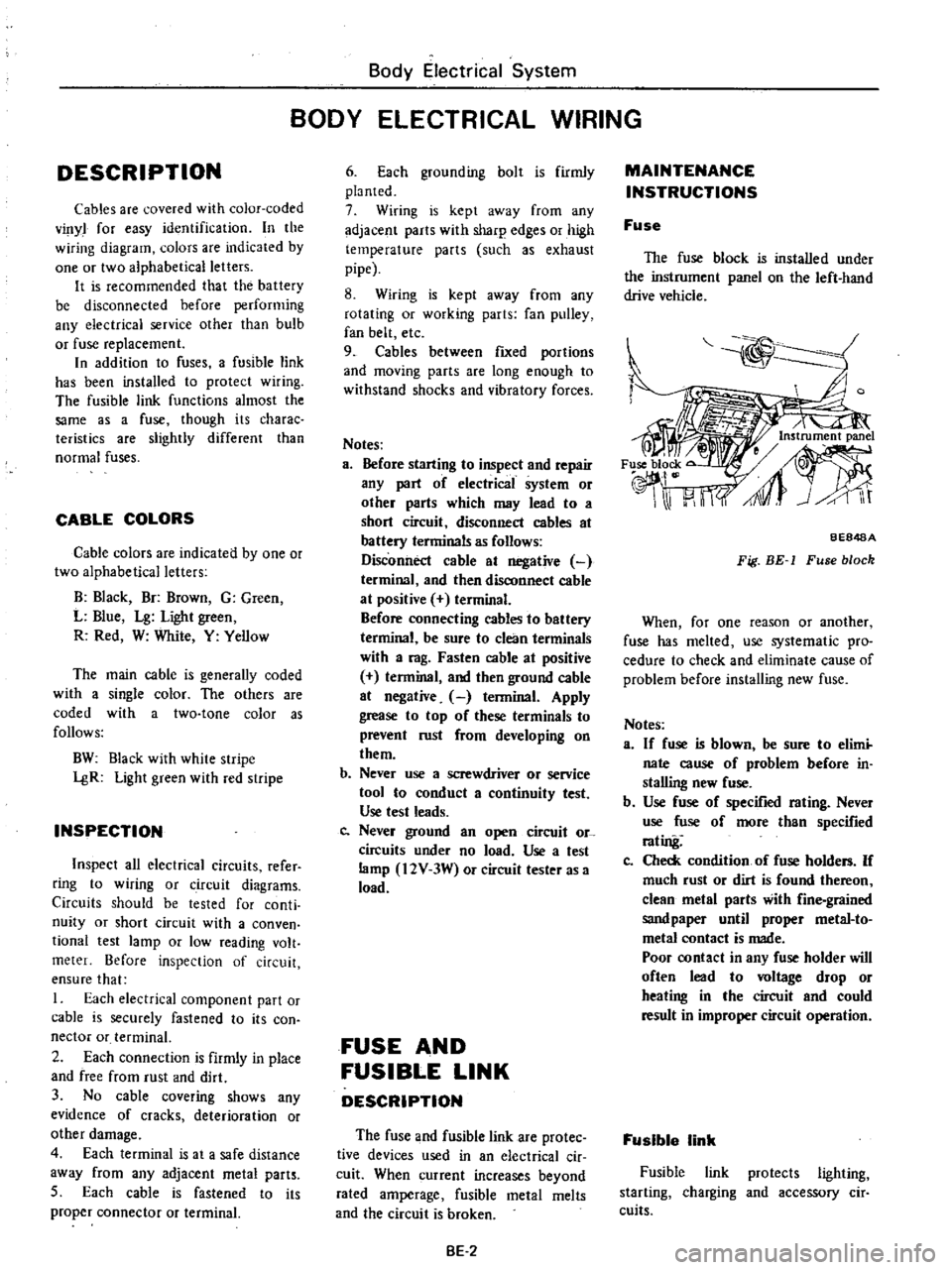
DESCRIPTION
Cables
are
covered
with
color
coded
vinyl
for
easy
identification
In
the
wiring
diagram
colors
are
indicated
by
one
or
two
alphabetical
letters
It
is
recommended
that
the
battery
be
disconnected
before
performing
any
electrical
service
other
than
bulb
or
fuse
replacement
In
addition
to
fuses
a
fusible
link
has
been
installed
to
protect
wiring
The
fusible
link
functions
almost
the
same
as
a
fuse
though
its
eharac
teristics
are
slightly
different
than
normal
fuses
CABLE
COLORS
Cable
colors
are
indicated
by
one
or
two
alphabetical
letters
B
Black
Be
Brown
G
Green
L
Blue
Lg
Light
green
R
Red
W
White
Y
Yellow
The
main
cable
is
generally
coded
with
a
single
color
The
others
are
coded
with
a
two
tone
color
as
follows
BW
Black
with
white
stripe
gR
Light
green
with
red
stripe
INSPECTION
Inspect
all
electrical
circuits
refer
ring
to
wiring
or
circuit
diagrams
Circuits
should
be
tested
for
conti
nuity
or
short
circuit
with
a
conven
tional
test
lamp
or
low
reading
volt
meter
Before
inspection
of
circuit
ensure
that
I
Each
electrical
component
part
or
cable
is
securely
fastened
to
its
con
nector
or
terminal
2
Each
connection
is
firmly
in
place
and
free
from
rust
and
dirt
3
No
cable
covering
shows
any
evidence
of
cracks
deterioration
or
other
damage
4
Each
terminal
is
at
a
safe
distance
away
from
any
adjacent
metal
parts
5
Each
cable
is
fastened
to
its
proper
connector
or
terminal
Body
Electrical
System
BODY
ELECTRICAL
WIRING
6
Each
grounding
bolt
is
firmly
pbnted
7
Wiring
is
kept
away
from
any
adjacent
parts
with
sharp
edges
or
high
temperature
parts
such
as
exhaust
pipe
8
Wiring
is
kept
away
from
any
rotating
or
working
parts
fan
pulley
fan
belt
etc
9
Cables
between
ftxed
portions
and
moving
parts
are
long
enough
to
withstand
shocks
and
vibratory
forces
Notes
a
Before
starting
to
inspect
and
repair
any
part
of
electrical
system
or
other
parts
which
may
lead
to
a
short
circuit
disconnect
cables
at
battery
terminals
as
follows
Disconnect
cable
at
negative
terminal
and
then
disconnect
cable
at
positive
terminal
Before
connecting
cables
to
battery
terminal
be
sure
to
clean
terminals
with
a
rag
Fasten
cable
at
positive
terminal
and
then
ground
cable
at
negative
terminal
Apply
grease
to
top
of
these
terminals
to
prevent
rust
from
developing
on
them
b
Never
use
a
screwdriver
or
senrice
tool
to
conduct
a
continuity
test
Use
test
leads
c
Never
ground
an
open
circuit
or
circuits
under
no
load
Use
a
test
lamp
12V
3W
or
circuit
tester
as
a
load
FUSE
AND
FUSIBLE
LINK
DESCRIPTION
The
fuse
and
fusible
link
are
protec
tive
devices
used
in
an
electrical
cir
cuit
When
current
increases
beyond
rated
amperage
fusible
metal
melts
and
the
circuit
is
broken
BE
2
MAINTENANCE
INSTRUCTIONS
Fuse
The
fuse
block
is
installed
under
the
instrument
panel
on
the
left
hand
drive
vehicle
BE848A
Fig
BE
1
Fuse
block
When
for
one
reason
or
another
fuse
has
melted
use
systematic
pro
cedure
to
check
and
eliminate
cause
of
problem
before
installing
new
fuse
Notes
a
If
fuse
is
blown
be
sure
to
elimi
nate
cause
of
problem
before
in
stalling
new
fuse
b
Use
fuse
of
specified
rating
Never
use
fuse
of
more
than
specified
rating
Co
Check
condition
of
fuse
holders
If
much
rust
or
dirt
is
found
thereon
clean
metal
parts
with
fine
grained
sandpaper
until
proper
metal
to
metal
contact
is
made
Poor
contact
in
any
fuse
holder
will
often
lead
to
voltage
drop
or
heating
in
the
circuit
and
could
result
in
improper
circuit
operation
Fusible
link
Fusible
link
protects
lighting
starting
charging
and
accessory
cir
cuits
Page 448 of 537

A
melted
fusible
link
can
be
de
tected
either
by
visual
inspection
or
by
feeling
with
finger
tip
If
its
condition
is
questionable
use
circuit
tester
or
test
lamp
as
required
to
conduct
continuity
test
This
continuity
test
can
be
performed
in
the
same
manner
as
for
any
conventional
fuse
Body
Electrical
System
Notes
a
If
fusible
link
should
melt
it
is
possible
that
critical
circuit
power
supply
or
large
current
carrying
circuit
is
shorted
In
such
a
case
carefully
check
and
eliminate
cause
of
problem
b
Never
wrap
periphery
of
fusible
link
with
vinyl
tape
Extreme
care
should
be
taken
with
this
link
to
ensure
that
it
does
not
come
into
contact
with
any
other
wiring
har
ness
or
vinyl
or
rubber
parts
c
BEB49A
Fig
BE
2
Fusible
link
LIGHTING
AND
SIGNAL
LAMP
SYSTEM
DESCRIPTION
LIGHTING
SYSTEM
CIRCUIT
DIAGRAM
HEADLAMP
HEAD
LAMP
BEAM
REPLACEMENT
AIMING
ADJUSTMENT
FRONT
COMBINATION
LAMP
BUL8
REPLACEMENT
REMOVAL
AND
INSTALLATION
SIDE
MARKER
LAMP
BUL8
REPLACEMENT
REMOVAL
AND
INSTALLATION
ROOM
LAMP
BULB
REPLACEMENT
REMOVAL
AND
INSTALLATION
REAR
COMBINATION
LAMP
BULB
REPLACEMENT
REMOVAL
AND
INSTALLATION
LICENSE
LAMP
BULB
REPLACEMENT
REMOVAL
AND
INSTALLATION
ENGINE
COMPARTMENT
LAMP
LIGHTING
SWITCH
REMOVAL
AND
INSTALLATION
INSPECTION
ILLUMINATION
CONTROL
RHEOSTAT
REMOVAL
AND
INSTALLATION
CONTENTS
BE
4
BE
4
BE
5
BE
5
BE
5
8E
7
BE
7
BE
7
8E
7
BE
7
8E
7
BE
8
BE
B
8E
8
BE
8
8E
8
8E
8
8E
8
BE
8
8E
8
BE
9
BE
9
BE
9
8E
9
8E
9
8E
9
INSPECTION
KN08
ILLUMINATION
LAMP
BULB
REPLACEMENT
LAMP
BODY
REPLACEMENT
TURN
SIGNAL
AND
DIMMER
SWITCH
REMOVAL
AND
INSTALLATION
INSPECTION
STOP
LAMP
SWITCH
REMOVAL
AND
INSTALLATION
INSPECTION
DOOR
SWITCH
REMOVAL
AND
INSTALLATION
INSPECTION
HAZARD
SWITCH
REMOVAL
AND
INSTALLATION
INSPECTION
FLASHER
UNIT
REPLACEMENT
8ULB
SPECIFICATIONS
TROUBLE
DIAGNOSES
AND
CORRECTIONS
HEAD
LAMP
TURN
SIGNAL
LAMP
TAIL
LAMP
STOP
LAMP
AND
BACK
UP
LAMP
BE
3
1
BE
9
BE
10
BE
10
BE10
BE
10
BE
10
BE
10
BE
10
BE
10
BE
10
BE
10
BE
10
BE
11
BE
11
BE
11
BE
11
8E
11
BE
11
BE
12
BE
12
BE
12
BE
13
8E
13
Page 449 of 537

Body
Electrical
System
DESCRIPTION
LIGHTING
SYSTEM
CI
RCUIT
DIAGRAM
Headlamp
tail
lamp
and
license
lamp
system
G
o
@
LI
U
CIl
HEADl
AMP
L
H
e
FRONT
SlOE
lIIIARI
ER
LAMP
IR
H
USl
LE
LINK
CJ
lOA
CJ
154
CJ
CJ
FUSE
BLOCK
I
2
IR
n
fMP
IL
H
l
REAR
SIDE
MARKER
LAMP
R
1
1
LIGHTING
SWITCH
l
J
ll
f
1121
I
r
1
x
DIMMER
SWITCH
101
1
I
ON
t
0
I
EA
i
METE
LAMP
ILLUMINATION
LAMP
jSTOPBrURH
STOP
8
TURN
TAIL
TAIL
BSAOC
UP
RE
AR
COMBINATION
LAMP
R
H
I
J
LICE
NSf
r
LAMP
I3
BACIC
UP
TA
L
ST
OP8TURN
TAIL
STOP8TURN
REAR
COMBINATION
LAMP
ILH
I
Q
REAR
SIDE
NAR
tAMP
BEBSOA
Fig
BE
3
Headlamp
tail
lamp
and
liceme
lamp
ay6t
m
Turn
signal
hazard
warning
lamp
stop
lamp
and
back
up
lamp
system
I
HEAOLAMP
R
H
l
CR
H
Ll
lHTINIi
j
nn
A
iNAnON
8A
LAMP
BATTERY
@
4j
Jl
FRONT
COM8IfUl
1ON
LAMP
H
FUSIBLE
LINK
I
a
FUSE
BLOCK
FUSE
FROM
IGNITION
SWITCH
@
h
FRONT
COMBINATION
LAMP
L
H
REAR
COMBINATION
LAMP
R
H
BACK
UP
LAMP
T
A
I
L
SWITCH
n
8ACK
UP
E
W
P
HAZARO
FLASHER
UNIT
HAIARD
2
ON
WA
NING
SWITCH
3
r
TU
N
SIGNAL
FLASHER
UNIT
CJ
U
t
N
iH
ij
I
STOP
t
H
J
EL
L
H
I
TURN
SIGNAL
INDICATOR
LAMP
TURN
SIGNAL
SWITCH
G
BACK
UP
JTA
STOP8TURN
TAIL
STOP
8
TURN
REAR
COMelNATlON
LAMP
IL
H
I
BE851A
Fig
BE
4
Turn
signal
Juuard
warning
lamp
stop
lamp
and
back
up
lamp
system
BE
4
Page 454 of 537
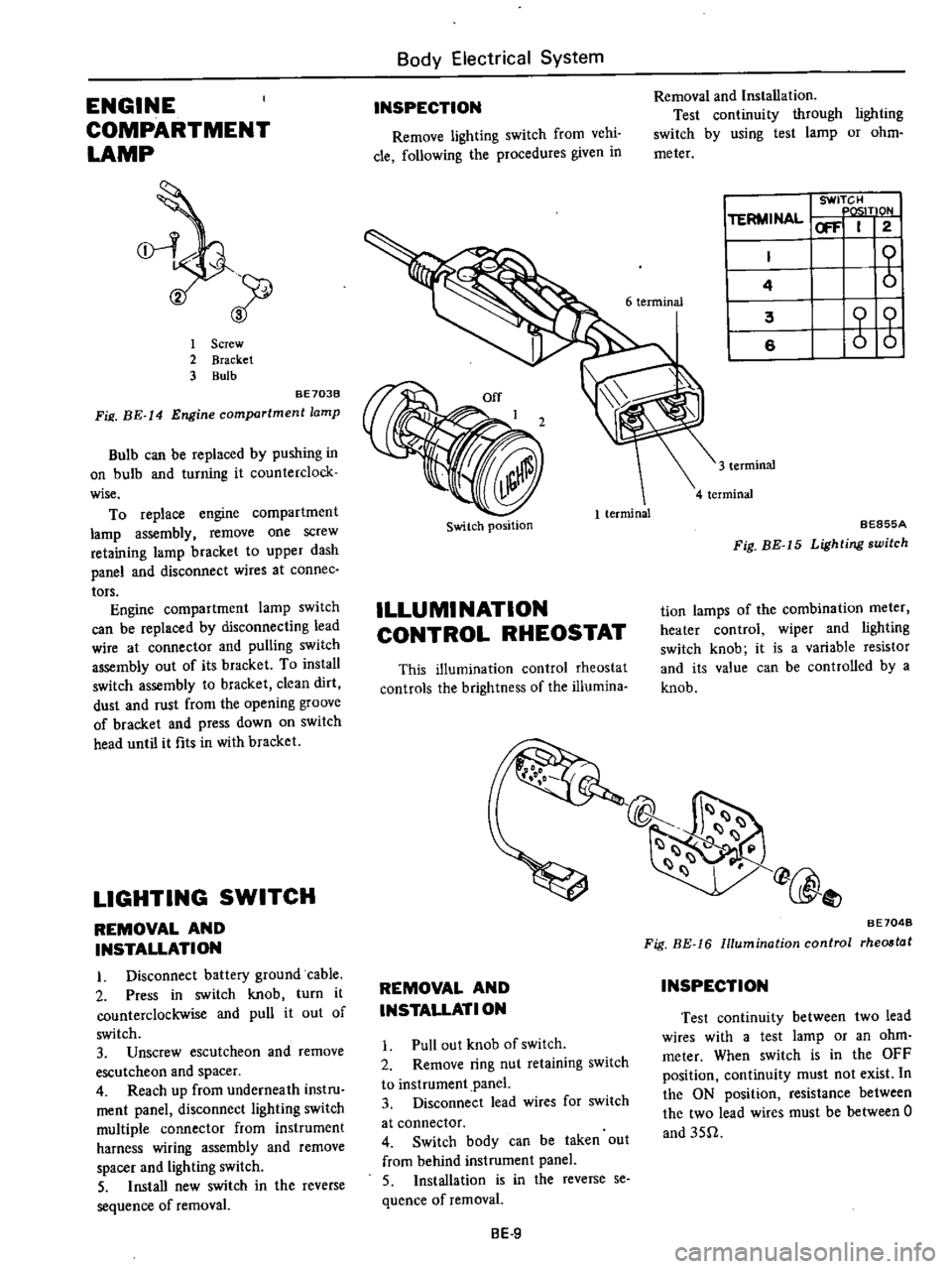
ENGINE
COMPARTMENT
LAMP
2
1
Screw
2
Bracket
3
Bulb
BE
7038
Fill
BE
14
Engine
compartment
lamp
Bulb
can
be
replaced
by
pushing
in
on
bulb
and
turning
it
counterclock
wise
To
replace
engine
compartment
lamp
assembly
remove
one
SCrew
retaining
lamp
bracket
to
upper
dash
panel
and
disconnect
wires
at
connee
tors
Engine
compartment
lamp
switch
can
be
replaced
by
disconnecting
lead
wire
at
connector
and
pulling
switch
assembly
out
of
its
bracket
To
install
switch
assembly
to
bracket
clean
dirt
dust
and
rust
from
the
opening
groove
of
bracket
and
press
down
on
switch
head
until
it
fits
in
with
bracket
LIGHTING
SWITCH
REMOVAL
AND
INSTALLATION
I
Disconnect
battery
ground
cable
2
Press
in
switch
knob
turn
it
counterclockwise
and
pull
it
out
of
switch
3
Unscrew
escutcheon
and
remove
escutcheon
and
spacer
4
Reach
up
from
underneath
instru
ment
panel
disconnect
lighting
switch
multiple
connector
from
instrument
harness
wiring
assembly
and
remove
spacer
and
lighting
switch
5
Install
new
switch
in
the
reverse
sequence
of
removal
Body
Electrical
System
INSPECTION
Remove
lighting
switch
from
vehi
cle
following
the
procedures
given
in
Switch
position
1
terminal
ILLUMINATION
CONTROL
RHEOSTAT
This
illumination
control
rheostat
controls
the
brightness
of
the
iliumina
Removal
and
Installation
Test
continuity
through
lighting
switch
by
using
test
lamp
or
ohm
meter
I
I
SWITCH
TERMINAL
P
T10N
ICI
F
2
I
I
b
I
4
I
I
6
terminal
I
3
I
6
3
terminal
4
terminal
BE855A
Fig
BE
15
Lighting
switch
tion
lamps
of
the
combination
meter
heater
control
wiper
and
lighting
switch
knob
it
is
a
variable
resistor
and
its
value
can
be
controlled
by
a
knob
REMOVAL
AND
INSTALLATION
I
Pull
out
knob
of
switch
2
Remove
ring
nut
retaining
switch
to
instrument
panel
3
Disconnect
lead
wires
for
switch
at
connector
4
Switch
body
can
be
taken
out
from
behind
instrument
panel
5
Installation
is
in
the
reverse
se
quence
of
removal
BE
9
0@
BE
7048
Fig
BE
16
Illumination
control
rhe08tat
INSPECTION
Test
continuity
between
two
lead
wires
with
a
test
lamp
or
an
ohm
meter
When
switch
is
in
the
OFF
position
continuity
must
not
exist
In
the
ON
position
resistance
between
the
two
lead
wires
must
be
between
0
and
3512
Page 455 of 537
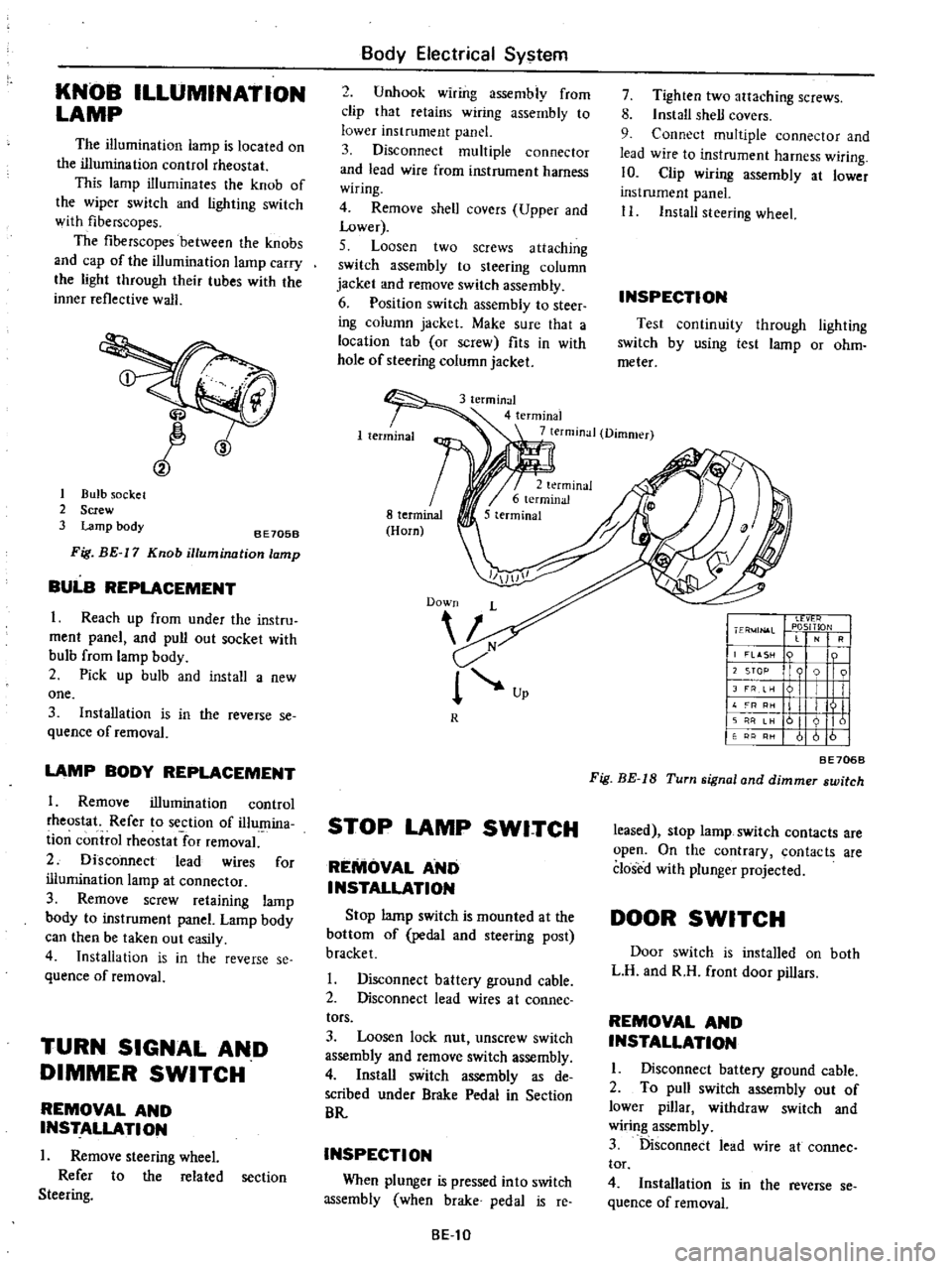
KNOB
ILLUMINATION
LAMP
The
illumination
lamp
is
located
on
the
illumination
control
rheostat
This
lamp
illuminates
the
knob
of
the
wiper
switch
and
lighting
switch
with
fiberscopes
The
fiberscopes
between
the
knobs
and
cap
of
the
illumination
lamp
carry
the
light
through
their
tubes
with
the
inner
reflective
walJ
CID
1
Bulb
socket
2
Screw
3
Lamp
body
8E705B
Fig
BE
17
Knob
illumination
lamp
BULB
REPLACEMENT
I
Reach
up
from
under
the
instru
ment
panel
and
pull
out
socket
with
bulb
from
lamp
body
2
Pick
up
bulb
and
install
a
new
one
3
Installation
is
in
the
reverse
se
quence
of
removal
LAMP
BODY
REPLACEMENT
1
Remove
illumination
control
rheostat
Refer
to
section
of
illumina
ti
on
control
rheostat
for
removal
2
Disconnect
lead
wires
for
illumination
lamp
at
connector
3
Remove
screw
retaining
lamp
body
to
instrument
panel
Lamp
body
can
then
be
taken
out
easily
4
Installation
is
in
the
reverse
se
quence
of
removal
TURN
SIGNAL
AND
DIMMER
SWITCH
REMOVAL
AND
INSTALLATION
I
Remove
steering
wheel
Refer
to
the
related
section
Steering
Body
Electrical
System
2
Unhook
wiring
assembly
from
clip
that
retains
wiring
assembly
to
lower
instrument
panel
3
Disconnect
multiple
connector
and
lead
wire
from
instrument
harness
wiring
4
Remove
shell
covers
Upper
and
Lower
5
Loosen
two
screws
attaching
switch
assembly
to
steering
column
jacket
and
remove
switch
assembly
6
Position
switch
assembly
to
steer
ing
column
jacket
Make
sure
that
a
location
tab
or
screw
fits
in
with
hole
of
steering
column
jacket
7
Tighten
two
attaching
screws
8
Install
shell
covers
9
Connect
multiple
connector
and
lead
wire
to
instrument
harness
wiring
10
Clip
wiring
assembly
at
lower
instrument
panel
II
Install
steering
wheel
INSPECTION
Test
continuity
through
lighting
switch
by
using
test
lamp
or
ohm
meter
3
terminal
4
terminal
7
terminal
Dimmer
R
STOP
LAMP
SWITCH
REMOVAL
AND
INSTALLATION
Stop
lamp
switch
is
mounted
at
the
bottom
of
pedal
and
steering
post
bracket
I
Disconnect
battery
ground
cable
2
Disconnect
lead
wires
at
coonee
tors
3
Loosen
lock
nut
unscrew
switch
assembly
and
remove
switch
assembly
4
Install
switch
assembly
as
de
scribed
under
Brake
Pedal
in
Section
BR
INSPECTION
When
plunger
is
pressed
into
switch
assembly
when
brake
pedal
is
reo
8El0
I
Ll
vt
r
I
ER
4JN
l
L
PlOSITlON
RI
j
LASH
n
I
I
12
STOP
9
91
I
JFRe
I
I
II
L
I
III
11
I
I
II
161
I
61616
BE706B
Fig
BE
IS
Turn
signal
and
dimmer
switch
leased
stop
lamp
switch
contacts
are
open
On
the
contrary
contacts
are
closed
with
plunger
projected
DOOR
SWITCH
Door
switch
is
installed
on
both
L
H
and
R
H
front
door
pillars
REMOVAL
AND
INSTALLATION
I
Disconnect
battery
ground
cable
2
To
pull
switch
assembly
out
of
lower
pillar
withdraw
switch
and
wiring
assembly
3
Disconnect
lead
wire
at
cannee
tor
4
Installation
is
in
the
reverse
se
quence
of
removal
Page 457 of 537

Body
Electrical
System
BULB
SPECIFICATIONS
Item
Wattage
Candlepower
Headlamp
Inner
Outer
37
5W
37
5
S0W
Front
combination
lamp
Turn
signal
and
parking
lamp
23
8W
32
3C
Side
marker
lamp
Front
Rear
8W
4C
8W
4C
Rear
combination
lamp
Turn
signal
lamp
A
B
Tail
lamp
B
C
Stop
lamp
A
B
Back
up
lamp
D
A
23W
32C
B
23j8W
32j3C
C
8W
4C
D
23W
32C
7
SW
6C
License
plate
lamp
Engine
compartment
lamp
6W
Room
lamp
5W
Combination
meter
illurnina
tion
17W
iC
x3
Knob
illumination
lamp
3
4W
2C
Heater
control
illumination
lamp
3
4W
2C
TROUBLEDIAGNOSE
AND
CORRECTIONS
HEADLAMP
Condition
Headlarnps
do
not
light
for
both
high
and
low
beams
High
beam
cannot
be
switched
to
low
beam
or
vice
versa
Probable
cause
Burnt
fuse
Loose
connection
or
open
circuit
Faulty
lighting
switch
Faulty
dimmer
switch
Faulty
light
relay
No
ground
Faulty
dimmer
switch
Faulty
light
relay
BE12
Bulb
SAE
trade
number
4001
4002
1034
67
67
1073
1034
67
1073
89
161
158
158
Corrective
action
Correct
cause
and
replace
fuse
Check
wiring
and
or
repair
connection
Conduct
continuity
test
and
replace
if
neces
sary
Check
light
relay
for
proper
operation
and
replace
if
necessary
Clean
and
tighten
ground
terminal
Conduct
continuity
test
and
replace
if
neces
sary
Check
light
relay
for
proper
operation
and
replace
if
necessary
Page 458 of 537
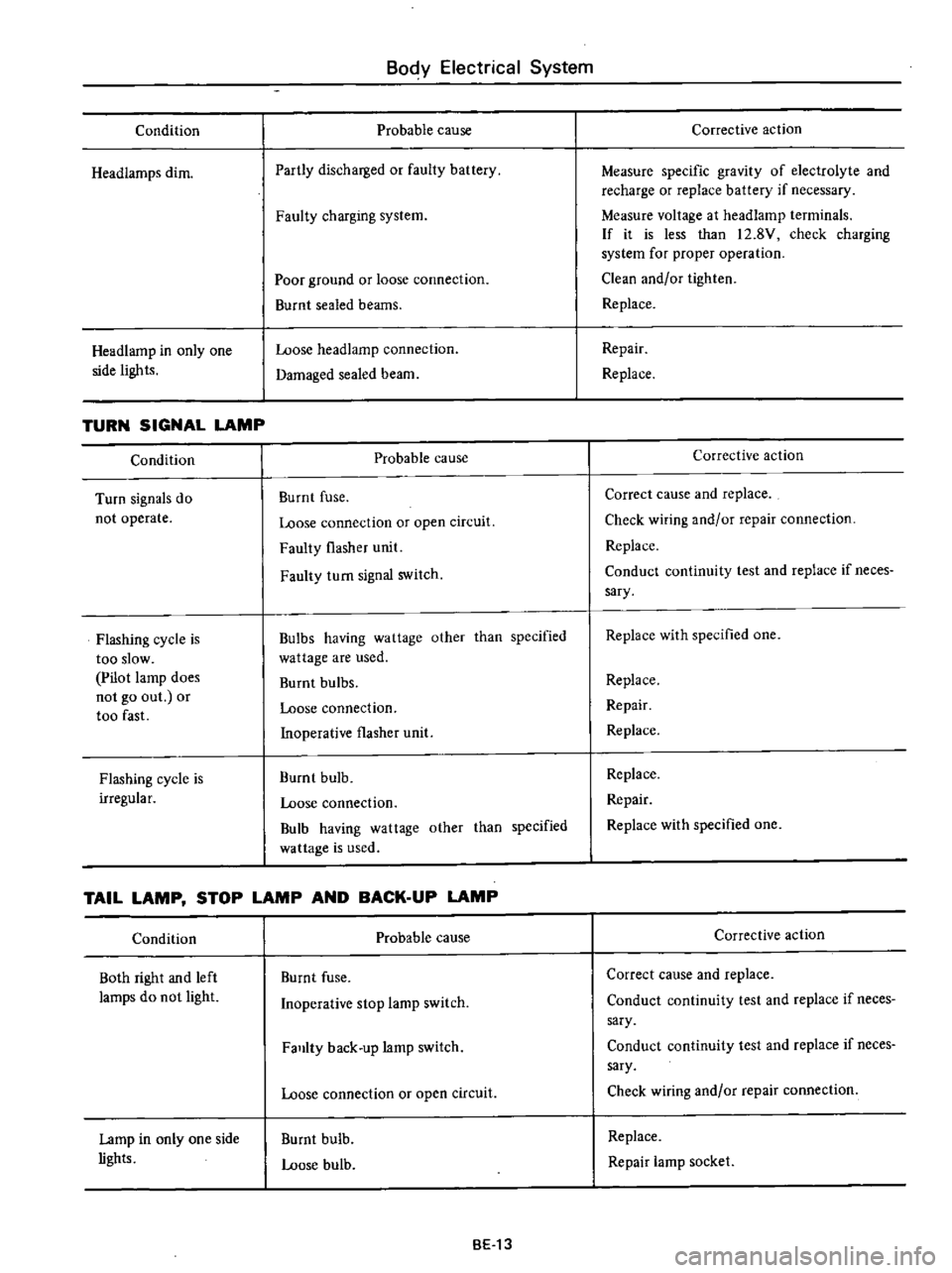
Condition
Headiamps
dim
Headlamp
in
only
one
side
lights
TURN
SIGNAL
LAMP
Condition
Turn
signals
do
not
operate
Flashing
cycle
is
too
slow
Pilot
lamp
does
not
go
out
or
too
fast
Flashing
cycle
is
irregular
Body
Electrical
System
Probable
cause
Partly
discharged
or
faulty
battery
Faulty
charging
system
Poor
ground
or
loose
connection
Burnt
sealed
beams
Loose
headlamp
connection
Damaged
sealed
beam
Probable
cause
Burnt
fuse
Loose
connection
or
open
circuit
Faulty
flasher
unit
Faulty
turn
signal
switch
Bulbs
having
wattage
other
than
specified
wattage
are
used
Burnt
bulbs
Loose
connection
Inoperative
flasher
unit
Burnt
bulb
Loose
connection
Bulb
having
wattage
other
than
specified
wa
ttage
is
used
TAIL
LAMP
STOP
LAMP
AND
BACK
UP
LAMP
Condition
Both
right
and
left
lamps
do
not
light
Lamp
in
only
one
side
lights
Probable
cause
Burnt
fuse
Inoperative
stop
lamp
switch
Falllty
back
up
lamp
switch
Loose
connection
or
open
circuit
Burnt
bulb
Loose
bulb
BE13
Corrective
action
Measure
specific
gravity
of
electrolyte
and
recharge
or
replace
battery
if
necessary
Measure
voltage
at
headlamp
terminals
If
it
is
less
than
12
8V
check
charging
system
for
proper
operation
Clean
and
or
tighten
Replace
Repair
Replace
Corrective
action
Correct
cause
and
replace
Check
wiring
and
or
repair
connection
Replace
Conduct
continuity
test
and
replace
if
neces
sary
Replace
with
specified
one
Replace
Repair
Replace
Replace
Repair
Replace
with
specified
one
Corrective
action
Correct
cause
and
replace
Conduct
continuity
test
and
replace
if
neces
sary
Conduct
continuity
test
and
replace
if
neces
sary
Check
wiring
and
or
repair
connection
Replace
Repair
lamp
socket
Page 460 of 537

Body
Electrical
System
Circuit
diagram
of
combination
meter
system
BATTERY
r
G
0
J
J
Z2
lIa
I
LlJ
I
Z
J
Z
a
z
J
z
Z
i
g
o
a
I
LlJ
I
ll
B
S
M
D
LIGHT
i
i
RELAY
i2i
mm
S
FROM
J
e
AMP
l1
l1
J
J
00
LlJLlJ
z
z
B
COO
CUT
n
SOLENOID
i
OIL
f
PRESSURE
SWITCH
THERMAL
a
TRANSMITTER
I
FUSIBLE
r
LINK
IGNITION
SWITCH
0
1
lOA
I
g
KG
lOA
r
I
15A
t
15A
i
7
5a
z
u
a
a
I
04LlJ
l1
J
o
02
u
3
FUEL
TANK
J
VOLTAGE
REGULATOR
HAND
BRAKE
SWITCH
J
Jon
0
j
Z
a
l
I
I
I
l
ll
Z
ll
Z
LlJ
LlJ
J
a
J
a
I
I
I
I
1
1
Zza
a
00
a
a
LlJLlJ
ll
ll
a
a
HAZARD
FLASHER
UNIT
L
J
HAZAR
D
SWITCH
I
OFF
ONI
l
I
I
I
2
I
I
3
I
14
61
I
5
6
16
9
I
76
I
FLASHER
UNIT
CJ
TO
LIGHT
IOFF
RELAY
B
l
TERMINAL
I
I
I
LIGHT
SWITCH
21
X
X
BEB57
A
Fig
BE
22
Circuit
diagram
of
combination
meter
ayatt
m
TURN
SIGNAL
SWITCH
I
L
RI
lFLA
I
IR
R
I
IR
L
I
IF
R
u
I
IF
L
u
I
FROM
L1GHT
RELAY
DIMMER
SWITCH
BE
15
Page 461 of 537
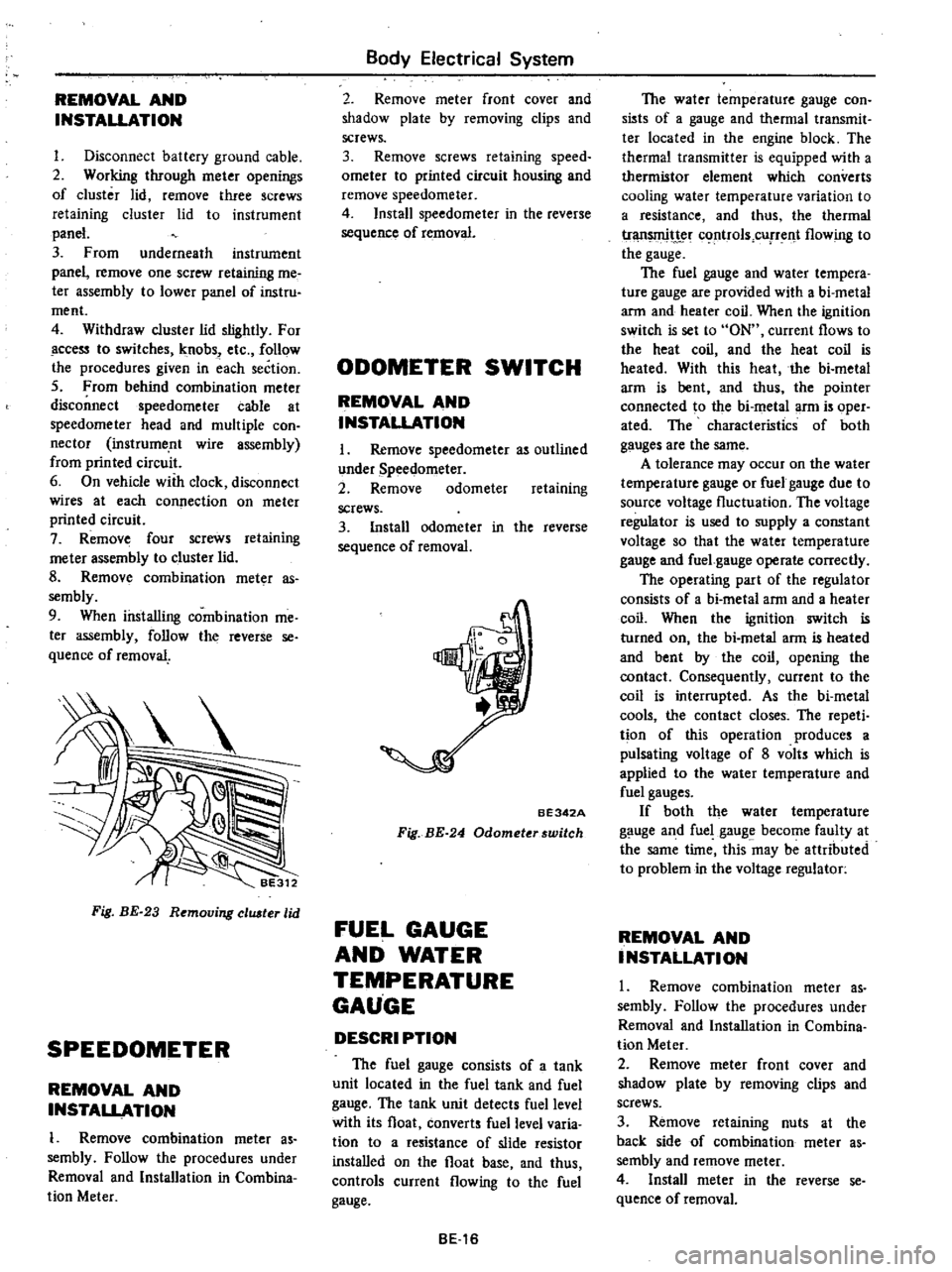
REMOVAL
AND
INSTALLATION
I
Disconnect
battery
ground
cable
2
Working
through
meter
openings
of
cluster
lid
remove
three
screws
retaining
cluster
lid
to
instrument
panel
3
From
underneath
instrument
panel
remove
one
screw
retaining
me
ter
assembly
to
lower
panel
of
instru
ment
4
Withdraw
cluster
lid
slightly
For
ccess
to
switches
knobs
etc
follow
the
procedures
given
in
each
section
5
From
behind
combination
meter
disconnect
speedometer
cable
at
speedometer
head
and
multiple
con
nector
instrume
nt
wire
assembly
from
printed
circuit
6
On
vehicle
with
clock
disconnect
wires
at
each
connection
on
meter
printed
circuit
7
Remove
four
screws
retaining
me
ter
assembly
to
cluster
lid
8
Remov
combination
meter
as
sembly
9
When
installing
combination
me
ter
assembly
follow
the
reverse
se
quence
of
removal
Fig
BE
23
Removing
eluster
lid
SPEEDOMETER
REMOVAL
AND
INSTALLATION
1
Remove
combination
meter
as
sembly
Follow
the
procedures
under
Removal
and
Installation
in
Combina
tion
Meter
Body
Electrical
System
2
Remove
meter
front
cover
and
shadow
plate
by
removing
clips
and
screws
3
Remove
screws
retaining
speed
ometer
to
printed
circuit
housing
and
remove
speedometer
4
Install
speedometer
in
the
reverse
sequence
of
removal
ODOMETER
SWITCH
REMOVAL
AND
INSTALLATION
I
Remove
speedometer
as
outlined
under
Speedometer
2
Remove
odometer
retaining
screws
3
Install
odometer
in
the
reverse
sequence
of
removal
BE342A
Fig
BE
24
Odometerswitch
FUEL
GAUGE
AND
WATER
TEMPERATURE
GAUGE
DESCRI
PTION
The
fuel
gauge
consists
of
a
tank
unit
located
in
the
fuel
tank
and
fuel
gauge
The
tank
unit
detects
fuel
level
with
its
float
converts
fuel
level
varia
tion
to
a
resistance
of
slide
resistor
installed
on
the
float
base
and
thus
controls
current
flowing
to
the
fuel
gauge
BE16
The
water
temperature
gauge
con
sists
of
a
gauge
and
thermal
transmit
ter
located
in
the
engine
block
The
thermal
transmitter
is
equipped
with
a
thermistor
element
which
converts
cooling
water
temperature
variation
to
a
resistance
and
thus
the
thermal
tr
t
c
rtrols
cUfTent
flowing
to
the
gauge
The
fuel
gauge
and
water
tempera
ture
gauge
are
provided
with
a
bi
metal
arm
and
heater
coil
When
the
ignition
switch
is
set
to
ON
current
flows
to
the
heat
coil
and
the
heat
coil
is
heated
With
this
heat
the
bi
metal
arm
is
bent
and
thus
the
pointer
connected
to
the
bi
metal
arm
is
oper
ated
The
characteristics
of
both
gauges
are
the
same
A
tolerance
may
occur
on
the
water
temperature
gauge
or
fuel
gauge
due
to
source
voltage
fluctuation
The
voltage
regulator
is
used
to
supply
a
constant
voltage
so
that
the
water
temperature
gauge
and
fuel
gauge
operate
correctly
The
operating
part
of
the
regulator
consists
of
a
bi
metal
arm
and
a
heater
coil
When
the
ignition
switch
is
turned
on
the
bi
metal
arm
is
heated
and
bent
by
the
coil
opening
the
contact
Consequently
current
to
the
coil
is
interrupted
As
the
bi
metal
cools
the
contact
closes
The
repeti
tion
of
this
operation
produces
a
pulsating
voltage
of
8
volts
which
is
applied
to
the
water
temperature
and
fuel
gauges
If
both
the
water
temperature
gauge
and
fuel
gauge
become
faulty
at
the
same
time
this
may
be
attributed
to
problem
in
the
voltage
regulator
REMOVAL
AND
INSTALLATION
1
Remove
combination
meter
as
sembly
Follow
the
procedures
under
Removal
and
Installation
in
Combina
tion
Meter
2
Remove
meter
front
cover
and
shadow
plate
by
removing
clips
and
screws
3
Remove
retaining
nuts
at
the
back
side
of
combination
meter
as
sembly
and
remove
meter
4
Install
meter
in
the
reverse
se
quence
of
removal